Brazil Soybean Weather – Introduction
Over the past 20 years, Brazil’s soybean production has been significantly impacted by weather conditions during the growing season. During that time Brazil has become a global powerhouse in the agriculture industry while developing into both a major producer and exporter of agricultural products. If you’ve asked yourself “Which country is the largest producer of soybeans in the world?” and answered “Brazil”, you’re correct. Agricultural production in Brazil has exploded over the past 20 years and its impact on global markets has been significant. Therefore, monitoring Brazil’s crop weather is important for any grain trader.
Brazil Soybean Weather – November 2020
A developing La Niña event late in 2020 is impacting Brazil’s weather conditions. La Niña will also impact Argentina’s crops.
The Brazil soybean production weighted average 90-day precipitation is 64% of normal. Such dry conditions will likely impact soybean supply in that country.
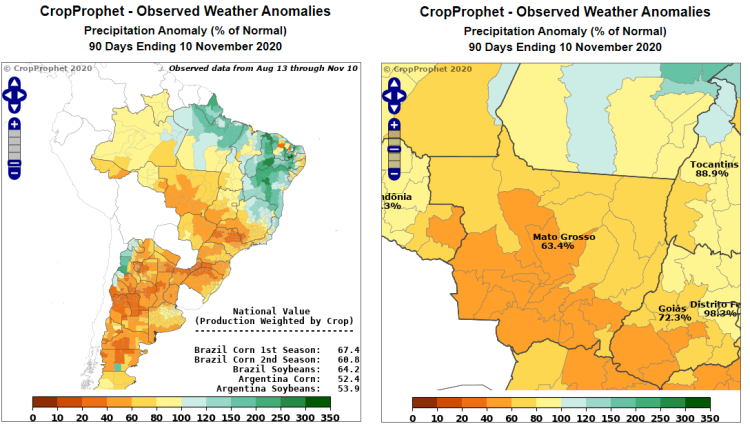
As discussed in this Forbes article, Brazil has over-committed exports to China and seeks to import soybeans from the United States to avoid soybean price spkes locally, despite becoming the top global soybean producer. Brazil was the number two producer of soybeans by 2018, according to the UN FAO.
Brazil is in the southern hemisphere which means the crop grows during months of the year roughly opposite on the calendar to the US crop season. Just as with the US crop season, “ag weather” conditions can have a significant impact on production on a year-to-year basis. Considering all these factors together indicates that monitoring the conditions of crop growth during the Brazilian crop season provides critical information regarding production totals in Brazil.
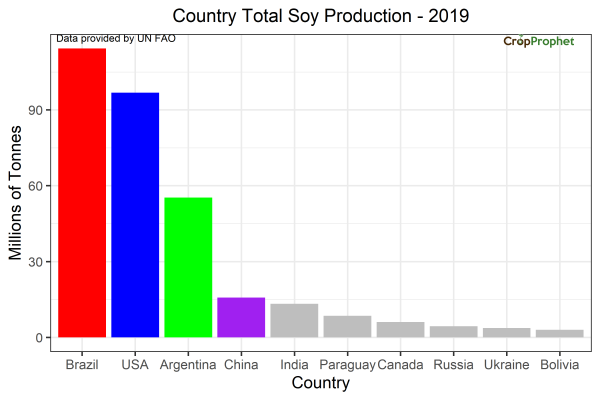
Note that in addition to the US and Brazil being top producers of soybeans, Argentina produces the third most soybeans in the world. Soybean production in all other countries is relatively small compared to US and Brazilian production.
Brazil Soybean Weather: Production
Understanding the impact of weather conditions on production requires understanding the Brazil crop calendar, and the regions where soybeans are planted. This is discussed below.
Brazil Crop Calendar

Crop calendars are used to highlight when critical activities occur during a region’s crop season. Those activities are generally planting, growth, and harvesting. The crop calendar above shows Brazilian soybean weather for planting occurs from October to December, the crop growth phase starts in January and harvesting occurs starting in March. So, the time of year that the Brazil soybean weather season is ending is similar to the time the crop season in the United States is just getting starting.
Brazil Soybean Production Map
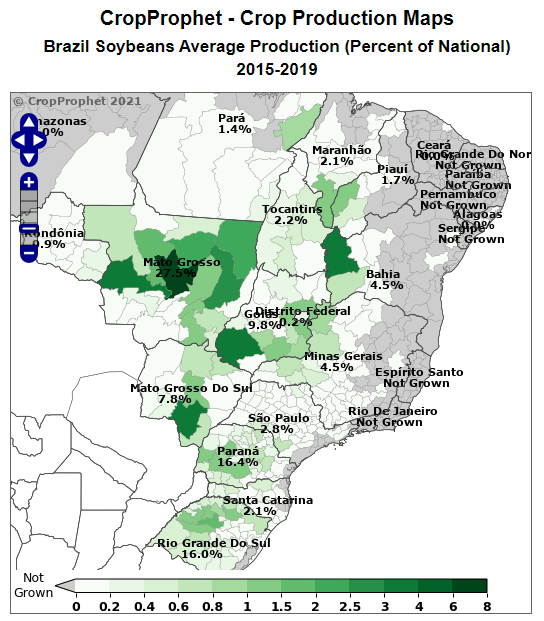
Although Brazil is geographically a very large country, Soybean production is fairly concentrated in a few regions in the west of the country including Mato Grosso and Goias. However, the three southern provinces of Rio Grande do Sul, Santa Catarina, and Paraná produce almost 35% of Brazilian soybeans. The maps above, which comes from the CropProphet product, shows the regions in Brazil where soybeans are produced.
Brazil Soybean Production and Exports
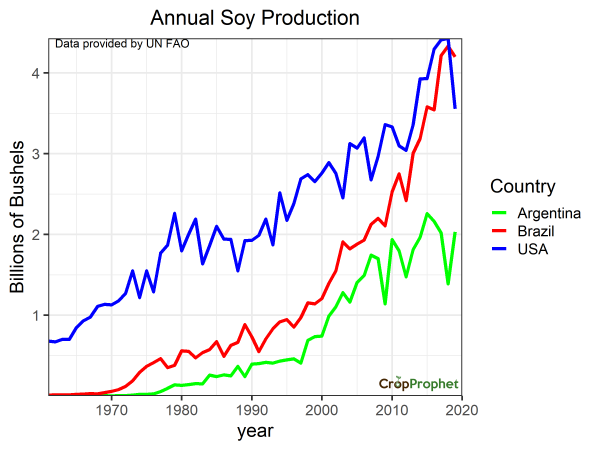
Brazil has grown to become a significant producer of soybeans over the past 20 to 30 years, as shown in the above history of soybean production. According to data provided by the UN FAO, Brazil’s soybean production surpassed United States production in 2019. Differences in Brazil soybean weather mean the increase year over year is not necessarily smooth. The Brazilian soybean production trends, however, suggest that Brazil will produce more soybeans than the United States for years to come.
Brazil soybean production is significant. This fact is only important if significant amounts are exported to other countries because Brazilian soybean exports create competition for US-grown soybeans. The degree of competition in global markets impacts the total US soybean exports. The impact of total US soybean exports impacts the total amount of soybeans available for sale in domestic US markets. This impact on US domestic supply affects the price of soybeans in the US market. As a result, US winter-time production of Brazilian soybeans can have direct impacts on the price of US soybean via its impact on global soybean export markets.
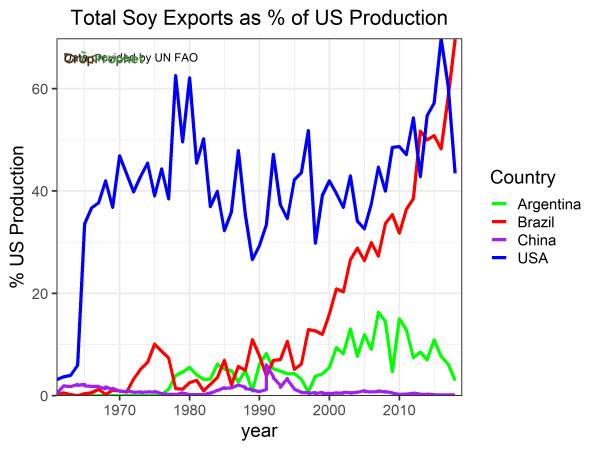
Soybean exports as a percent of total US production for each year are shown in the chart above. It demonstrates that Brazilian soybean exports have increased to roughly the same percentage as the US soybean exports up to 2017. Both countries exported approximately 40% relative to US production as of 2017. However, in 2018 Brazilian Soybean exports exploded to greater than 60% of US soybean production. Clearly, Brazil has grown to dominate global soybean markets relative to its primary rival, the United States.
Brazil Soybean Yield History
Brazilian soybean yields are approximately the same as those in the United States. There are two primary causes of year-to-year yield variation. The first is the technology trend. The yield technology trend is everything technological working to increase crop yields year in and year out. This includes but is not limited to seed genetics and technology, machinery technology, farming practices. The second cause is weather variations.
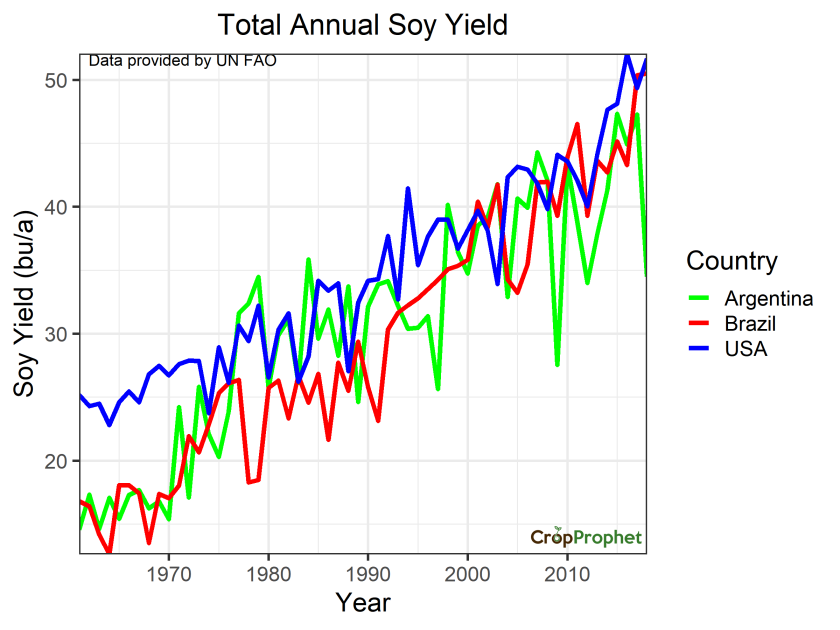
Using the Brazil soybean yield history in the chart above, the technology trend is estimated as the linear trend of yields from 1971 to 2017. Removing the linear trend (i.e. the technology trend) reveals the Brazil soybean yield variations over time. These yield variations are caused by different weather conditions during the growing season in Brazil.
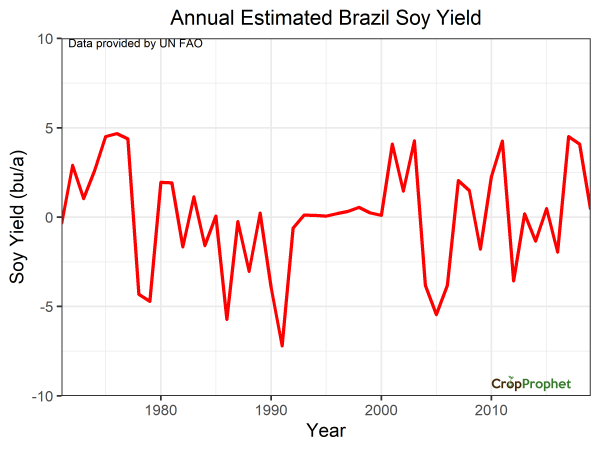
Significant variations in year-to-year soybean yield mean that overall Brazilian production can be significantly impacted by growing season weather conditions. Monitoring Brazil soybean weather during the Brazilian crop season is important to estimating Brazilian soybean production and the impact of exports on global markets.
CropProphet Brazil Soybean Weather Monitoring Solution
CropProphet, provided by Prescient Weather, is a popular tool for sophisticated agricultural futures traders to monitor crop yield predictions and the weather and climate conditions that cause year-to-year variations in yield and production. In November 2019 CropProphet released a content upgrade that offers customers the ability to monitor crop-specific weather conditions in Brazil and Argentina, such as the information below.
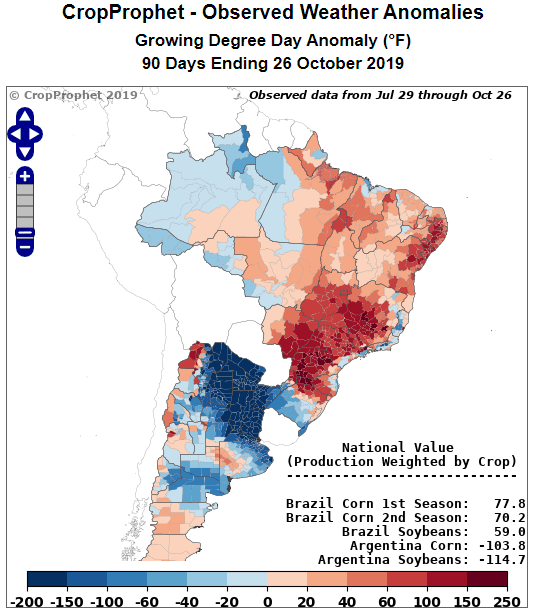
CropProphet is available to professional users for a trial. Request your trial today.